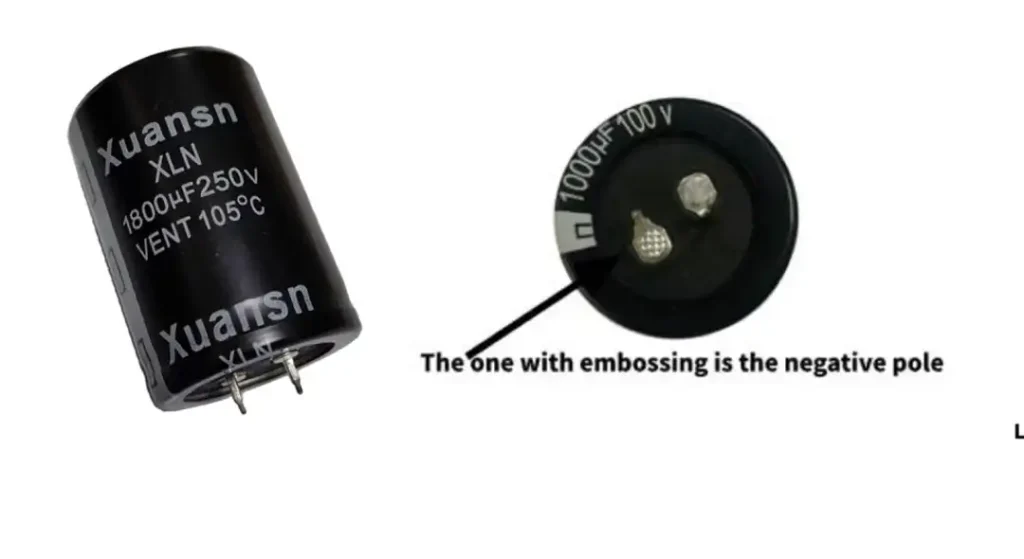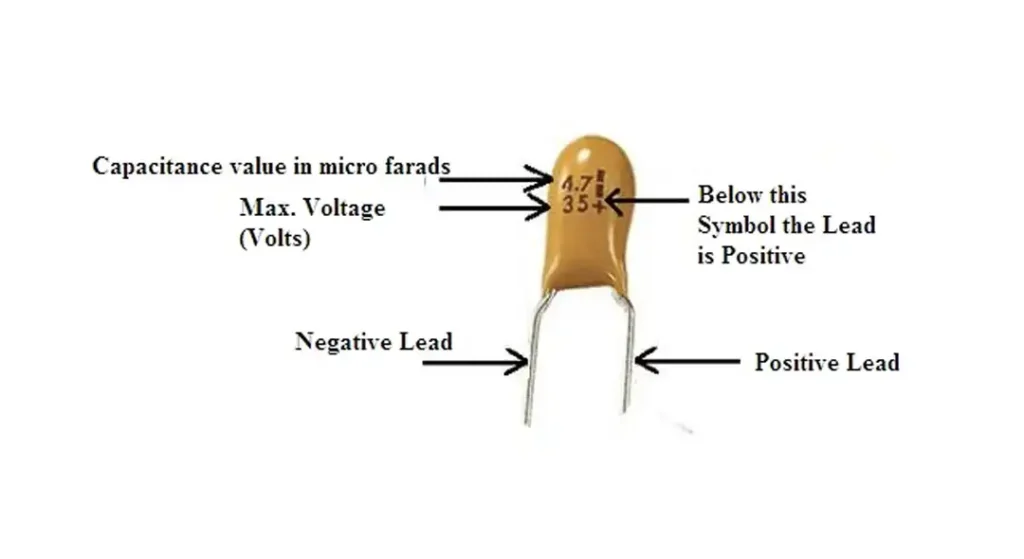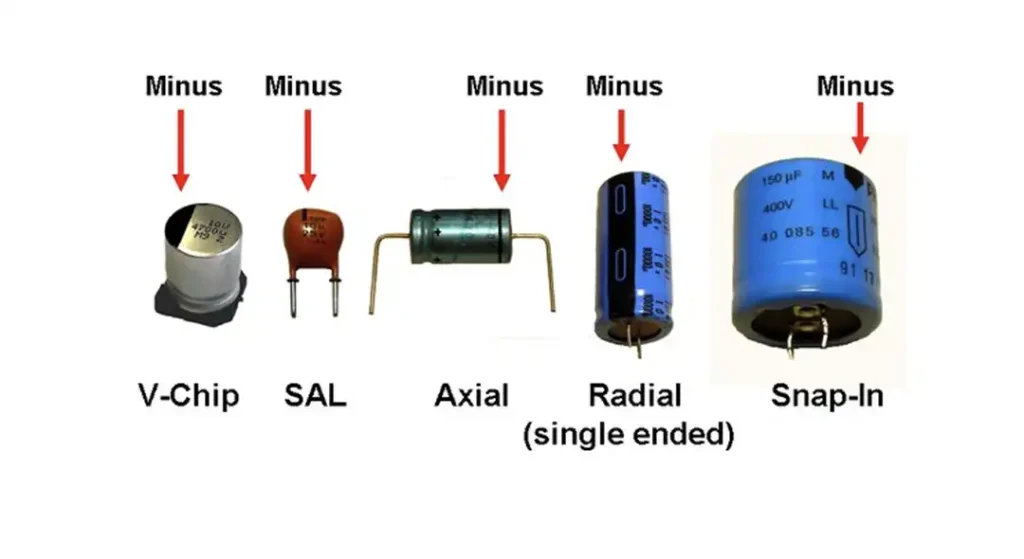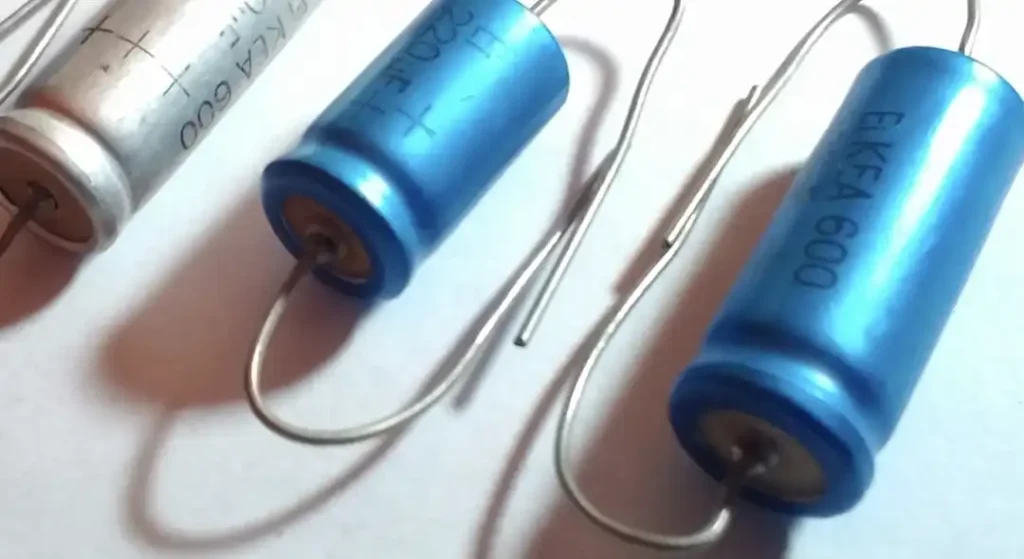In electronics, capacitors play a crucial role in storing and releasing electrical energy. Understanding the polarity of capacitors is fundamental to their proper functioning and integration into circuits.
What Is the Polarity of Capacitor

The polarity of a capacitor refers to its specific orientation within an electronic circuit. Capacitors are electronic components that store and release electrical energy. They consist of two conductive plates separated by a dielectric material.
In polarized capacitors, such as electrolytic capacitors, it’s crucial to connect them in a certain way, ensuring that the positive terminal is connected to the positive side of the circuit and the negative terminal to the negative side. If connected incorrectly, polarized capacitors can malfunction, overheat, or even explode.
On the other hand, non-polarized capacitors can be connected in either direction within a circuit without causing any issues. These capacitors are often used in audio circuits and timing applications where polarity is not critical.
Understanding the polarity of capacitors is essential for proper circuit functionality and to prevent damage to electronic components. It involves ensuring that polarized capacitors are connected correctly according to their positive and negative terminals.
Importance of Capacitor Polarity
The importance of capacitor polarity lies in its significant impact on the functionality and safety of electronic circuits. Capacitors are essential components in various electronic devices and systems, where they store and release electrical energy.
Here are some key reasons why capacitor polarity is crucial:
- Proper Functionality: Polarized capacitors, such as electrolytic capacitors, must be connected in a specific orientation within a circuit. This ensures that the positive terminal of the capacitor is aligned with the positive voltage and the negative terminal with the negative voltage. Correct polarity ensures that the capacitor operates as intended and effectively performs its function in the circuit.
- Preventing Damage: Incorrectly connecting polarized capacitors can lead to reverse polarity, where the positive and negative terminals are swapped. Reverse polarity can cause the capacitor to malfunction, overheat, or even explode. By adhering to the correct polarity, the risk of damage to the capacitor and other components in the circuit is minimized.
- Maintaining Circuit Integrity: In circuits where polarity is critical, such as in direct current (DC) applications, ensuring proper capacitor orientation is essential for maintaining circuit integrity. Incorrect polarity can disrupt the flow of current and lead to circuit malfunction or failure.
- Safety Considerations: Capacitors can store significant amounts of electrical energy, especially in high-voltage circuits. Connecting polarized capacitors with the wrong polarity can result in hazardous conditions, including short circuits or electrical fires. Adhering to correct polarity guidelines helps ensure the safety of both the circuit and the individuals interacting with it.
- Optimizing Performance: Capacitors play crucial roles in various circuit functions, including filtering, timing, and energy storage. Ensuring correct polarity allows capacitors to perform optimally, contributing to the overall efficiency and performance of electronic devices and systems.
Understanding and adhering to capacitor polarity guidelines are essential for maintaining circuit functionality, preventing damage, ensuring safety, and optimizing performance in electronic applications. Proper polarity ensures that capacitors operate effectively within circuits, contributing to the reliability and longevity of electronic devices.
Polarity of Tantalum Capacitor

Tantalum capacitors are polarized capacitors commonly used in electronic circuits due to their high capacitance values and stability. Understanding the polarity of tantalum capacitors is crucial for their proper integration and functioning within circuits.
Tantalum capacitors typically have a cylindrical or rectangular shape with two leads emerging from one end. The polarity of tantalum capacitors is denoted by markings on the capacitor body, which indicate the positive (+) and negative (-) terminals.
The positive terminal of a tantalum capacitor is usually marked with a plus sign (+) or a longer lead, while the negative terminal is indicated by a minus sign (-) or a shorter lead. It’s important to connect tantalum capacitors with the correct polarity orientation to prevent reverse voltage application, which can lead to catastrophic failure, overheating, or even explosion of the capacitor.
When installing tantalum capacitors in a circuit, always verify the polarity markings and ensure that the positive terminal is connected to the positive voltage supply and the negative terminal to the ground or negative voltage reference. Adhering to proper polarity guidelines is essential for the reliable operation and longevity of circuits incorporating tantalum capacitors.
Capacitor Polarity Marking

Capacitor polarity marking refers to the symbols, indicators, or labels on a capacitor that denote its polarity, indicating which terminal is positive (+) and which is negative (-). These markings are essential for correctly orienting polarized capacitors within an electronic circuit to ensure proper functionality and prevent damage.
Here are some common types of capacitor polarity markings:
- Plus Sign (+) and Minus Sign (-): Many polarized capacitors, such as electrolytic capacitors, feature a plus sign (+) near the positive terminal and a minus sign (-) near the negative terminal. These symbols clearly indicate the polarity of the capacitor and help ensure correct orientation during installation.
- Color Bands: Some capacitors use color bands to denote polarity. For example, the positive terminal may have a colored band, while the negative terminal remains unmarked or has a different color band. These color codes provide visual cues for polarity identification.
- Arrow Symbols: In some cases, polarized capacitors may feature arrow symbols pointing towards the negative terminal or away from the positive terminal. These arrow markings indicate the direction of polarity and help users align the capacitor correctly within the circuit.
- Text Labels: Capacitors may also include text labels such as “Positive” or “Negative” next to the respective terminals to indicate polarity. These labels provide clear instructions for polarity identification, especially for users who may be unfamiliar with standard polarity symbols.
- Physical Design: In addition to markings, the physical design of the capacitor can sometimes indicate polarity. For example, the positive terminal may be longer or have a different shape than the negative terminal, providing a tactile or visual clue for polarity orientation.
It’s essential to carefully inspect and follow the polarity markings on capacitors when installing them in a circuit. Connecting capacitors with incorrect polarity can lead to circuit malfunction, damage to components, or safety hazards. Therefore, verifying polarity markings before soldering or connecting capacitors is critical for the reliability and performance of electronic devices and systems.
Capacitor Polarity Axial

In axial capacitors, the terminals are typically located at opposite ends of the cylindrical body and extend outward in the same axis as the body. One terminal is designated as positive (+), while the other is negative (-), indicating the polarity of the capacitor.
Here’s a brief explanation:
- Axial Orientation: Axial capacitors have their terminals positioned at each end of the cylindrical body, aligned along the axis of the capacitor. This design allows for straightforward installation and soldering in through-hole circuits.
- Terminal Identification: One terminal of the axial capacitor is marked or indicated as positive (+), while the other is designated as negative (-). This polarity designation is essential for proper orientation within the circuit, ensuring correct functionality and preventing damage.
- Visual Inspection: Axial capacitors can often be visually identified by their cylindrical shape with leads extending from each end. The positive terminal may be longer than the negative terminal in some cases, providing a visual clue to polarity.
- Datasheets: Consulting the datasheet or specifications provided by the capacitor manufacturer can confirm the polarity of axial capacitors. The datasheet typically includes information about terminal orientation, capacitance value, voltage rating, and other relevant details.
Understanding the polarity and axial orientation of capacitors is crucial for correctly integrating them into electronic circuits. This ensures optimal performance, reliability, and safety of the circuit and its components.
Capacitor Polarity Identification
Capacitor polarity identification refers to the process of determining the orientation or polarity of a capacitor within an electronic circuit. It’s crucial to correctly identify capacitor polarity, especially for polarized capacitors such as electrolytic capacitors, to ensure proper circuit functionality and prevent damage.
Here are some common methods for identifying capacitor polarity:
- Markings: Many polarized capacitors have markings or indicators on their casing to denote polarity. These markings typically include symbols such as “+” or “-” near the terminals, indicating the positive and negative terminals, respectively.
- Color Coding: Some capacitors use color coding to indicate polarity. For example, the positive terminal may be marked with a colored band, while the negative terminal remains unmarked or has a different color band.
- Physical Shape: In some cases, polarized capacitors may have a distinctive physical shape or design, such as a longer lead on one terminal compared to the other. This asymmetry can help identify the positive and negative terminals.
- Datasheets: Consulting the datasheet or specifications provided by the capacitor manufacturer is another reliable way to identify polarity. Datasheets typically include information about terminal polarity, capacitance value, voltage rating, and other relevant details.
- Visual Inspection: Carefully examining the capacitor and its surroundings in the circuit can also provide clues about polarity. Tracing the connections and observing any markings or indicators nearby can help confirm the correct orientation.
It’s essential to use multiple identification methods and cross-reference them to ensure accuracy. Incorrectly identifying capacitor polarity can lead to circuit malfunction, damage to components, or safety hazards. Therefore, thorough verification is necessary before soldering or connecting capacitors within an electronic circuit.
Capacitor Polarity Schematic
A capacitor polarity schematic is a visual representation or diagram that illustrates the correct orientation of capacitors within an electronic circuit. This schematic typically depicts the positive (+) and negative (-) terminals of polarized capacitors and indicates how they should be connected relative to other components in the circuit.
Here’s an example of what a capacitor polarity schematic might look like:
+—| |—| |—| | | C1 | | | — — VCC(+) GND(-)In this schematic:
- “C1” represents the polarized capacitor.
- The positive terminal (+) of the capacitor is connected to the positive voltage supply, often denoted as “VCC.”
- The negative terminal (-) of the capacitor is connected to the ground (GND) or negative voltage reference.
The schematic provides clear guidance on how to correctly orient the capacitor within the circuit to ensure proper functionality and prevent polarity-related issues. Following the polarity schematic during circuit assembly helps avoid mistakes that could lead to capacitor damage or circuit malfunction.
How to Determine Polarity of a Capacitor
Determining the polarity of a capacitor is crucial for its correct integration into an electronic circuit. Here’s a step-by-step guide on how to determine the polarity of a capacitor:
- Check for Markings: Look for any markings or symbols on the capacitor body that indicate polarity. These markings typically include a plus sign (+) or a minus sign (-) near one of the terminals, denoting the positive and negative terminals, respectively. Some capacitors may also use color bands or arrow symbols to indicate polarity.
- Inspect Lead Length: In polarized capacitors, such as electrolytic capacitors, the leads may have different lengths. The positive lead is often longer than the negative lead. Additionally, the positive lead may be thicker or have a different shape compared to the negative lead. Inspecting the lead length and shape can provide clues about the capacitor’s polarity.
- Refer to Datasheet: Consult the datasheet or specifications provided by the capacitor manufacturer. Datasheets typically include information about terminal polarity, capacitance value, voltage rating, and other relevant details. Referencing the datasheet can confirm the polarity of the capacitor and provide additional information about its specifications.
- Use a Multimeter: If polarity markings are not visible or if you’re unsure about the capacitor’s polarity, you can use a multimeter to determine polarity. Set the multimeter to measure resistance (ohms) and touch the probes to the capacitor’s terminals. The multimeter will display a low resistance reading for one direction and a high resistance reading for the other direction. The terminal with the lower resistance reading corresponds to the positive terminal, while the terminal with the higher resistance reading is the negative terminal.
- Verify with Circuit Diagram: If the capacitor is part of a circuit, refer to the circuit diagram or schematic. The polarity of capacitors may be indicated in the diagram, specifying which terminal should be connected to the positive voltage supply and which terminal should be connected to the ground or negative voltage reference.
By following these steps and carefully inspecting the capacitor, you can determine its polarity and ensure correct orientation within the circuit. Correctly identifying capacitor polarity is essential for preventing circuit malfunction, damage to components, and ensuring the reliable operation of electronic devices and systems.
Are Capacitors Polarity Sensitive?
Yes, capacitors can be polarity sensitive, depending on their type. Polarized capacitors, such as electrolytic capacitors and tantalum capacitors, are inherently polarity sensitive. These capacitors have specific positive and negative terminals, and connecting them incorrectly can lead to circuit malfunction, damage to components, or even capacitor failure.
In contrast, non-polarized capacitors, such as ceramic capacitors and film capacitors, are not polarity sensitive. They can be connected in either direction within a circuit without affecting their performance or functionality.
It’s crucial to pay attention to the polarity sensitivity of capacitors, especially when working with polarized capacitors in electronic circuits. Always check for polarity markings, symbols, or lead orientation on the capacitor body to ensure correct orientation during installation. Adhering to proper polarity guidelines is essential for the reliable operation and longevity of circuits incorporating capacitors.
Conclusion
Understanding capacitor polarity is paramount for anyone working with electronic circuits. By recognizing the types, symptoms, causes, and treatment options for polarity-related issues, individuals can ensure the proper functioning and longevity of electronic devices and systems.